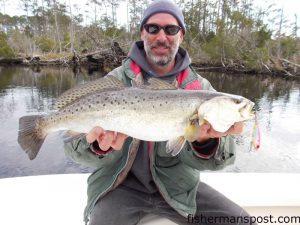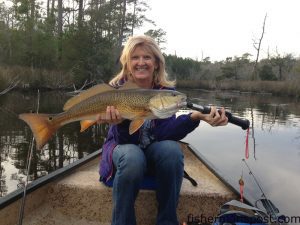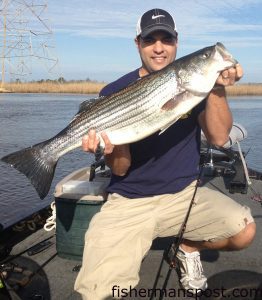Topsail March 7, 2013
Chris, of East Coast Sports, reports that the speckled trout bite has been going strong all winter in the local creeks, and it remains solid, with many anglers putting together limit catches (and some fish to 7 lbs.). Both the creeks off the ICW and the New River have been producing solid numbers of fish, but they seem a bit more concentrated in the New River area. MirrOlure MR17’s in the 808 color pattern have been some of the most effective baits lately, but a variety of soft plastic lures will also tempt the specks to bite. The trout action should only get better as the water warms up and the fish become a bit more active.
Anglers are picking up a few red drum mixed in with the specks and at other spots (like docks) inshore. Surf casters are also connecting with an occasional red, and it seems the main body of fish are still in the ocean. They’ll be moving back into the inlets and inshore as the water temperature warms with the coming of spring.
A few flounder are also feeding inshore in the area and falling for baits that anglers are casting for the specks and reds, and like both other fish, they’ll become more numerous and active as the mercury rises.

Tim Chavez with a fat speckled trout that bit an MR17 MirrOlure in 1′ of water off the New River while he was fishing with Capt. Allen Jernigan of Breadman Ventures.
Surf casters can also look forward to the arrival of some black drum, sea mullet, and pufferfish in the coming weeks. Shrimp on bottom rigs will tempt bites from all the bottom feeders.
Once the nearshore water temperatures hit 60 degrees, anglers should see the spring run of Atlantic bonito at spots like Diver’s Rock. While it may be well into April before that happens, it pays to keep an eye on the water temps in case there’s an early showing.
Offshore, boats that make the run to the break should be able to find some wahoo and blackfin tuna action while trolling ballyhoo and artificial lures.
Daniel of Flat Foot Charters, reports that the speckled trout that have been in the area all winter should become more active as March wears on and the water temperatures rise. The creeks and deeper channels are the places to go seeking the specks. Gulp baits and other soft plastics are the best bets for the specks until live shrimp become available.
Red drum will be feeding everywhere from the backwater flats to the surf zone in the coming weeks, and they’ll be in large schools in many of those places. Dead and cut baits are excellent choices for the reds in the cooler winter water, and they may also take an interest in topwater plugs and soft plastic baits inshore.

Susan Darnell, of Wilmington, NC, with a 6.6 lb. red drum she hooked in a creek off the New River after it struck a Gulp shrimp under a popping cork while she was fishing with Ronnie Riggs.
While the water remains cool, searching for fish on sunny days around shallow areas with dark bottom is typically the best bet. Falling tides offer warmer water than incoming and, consequently, often the best fishing.
Black drum are feeding around deep water structure inshore, and some large ones are typically caught during March and April. Fresh shrimp on bottom rigs are tough for the striped drum to turn down.
Allen, of Breadman Ventures, reports that the speckled trout and red drum action has gone on all winter long, and anglers are still connecting with plenty of both fish in the shallows of local creeks and bays. MirrOlure Mr17’s in the 808 color and Texas Tackle Factory soft plastics have been the most productive lures this season and are still putting fish in the boat.
A few flounder are starting to show up in the same areas as the trout and reds, and they’re taking an interest in the soft plastic baits as well. Warming water temperatures over the coming month should enhance the flounder action.

